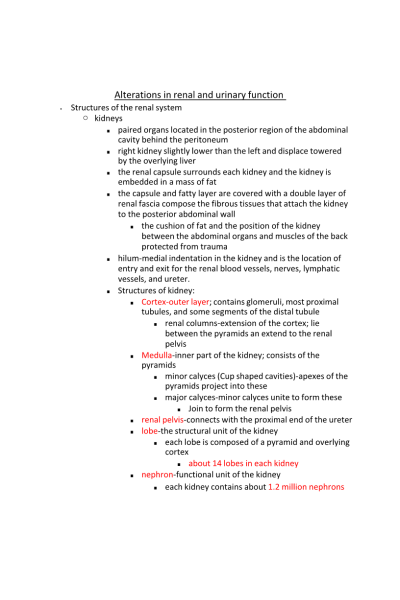NR 507 Week 4 Notes-Alterations in renal and urinary function
-
$10.00
| Institution | NR 507 Advanced Pathophysiology |
| Contributor | Mireille |
Alterations in renal and urinary function
- Structures of the renal system
- kidneys
- paired organs located in the posterior region of the abdominal cavity behind the peritoneum
- right kidney slightly lower than the left and displace towered by the overlying liver
- the renal capsule surrounds each kidney and the kidney is embedded in a mass of fat
- the capsule and fatty layer are covered with a double layer of renal fascia compose the fibrous tissues that attach the kidney to the posterior abdominal wall
- the cushion of fat and the position of the kidney between the abdominal organs and muscles of the back protected from trauma
- hilum-medial indentation in the kidney and is the location of entry and exit for the renal blood vessels, nerves, lymphatic vessels, and ureter.
- Structures of kidney:
- Cortex-outer layer; contains glomeruli, most proximal tubules, and some segments of the distal tubule
- renal columns-extension of the cortex; lie between the pyramids an extend to the renal pelvis
- Medulla-inner part of the kidney; consists of the pyramids
- minor calyces (Cup shaped cavities)-apexes of the pyramids project into these
- major calyces-minor calyces unite to form these
- Join to form the renal pelvis
- renal pelvis-connects with the proximal end of the ureter
- lobe-the structural unit of the kidney
- each lobe is composed of a pyramid and overlying cortex
- about 14 lobes in each kidney
- each lobe is composed of a pyramid and overlying cortex
- nephron-functional unit of the kidney
- each kidney contains about 1.2 million nephrons
- Cortex-outer layer; contains glomeruli, most proximal tubules, and some segments of the distal tubule
- kidneys
- the renal corpuscle
- bowman capsule
- glomerulus
- proximal convoluted tubule
- bowman capsule
- loop of Henle (nephron ansa)
- distal convoluted tubule
- collecting duct
- all of these contribute to the formation of urine
- the different epithelial cells lining various segments of the tubule facilitate the special functions of reabsorption and secretion
- three kinds of nephrons:
- superficial cortical nephrons (85%)-extend partially into the medulla
- midcortical nephrons with short or long loops
- juxtamedullary nephrons-like close to an extend deep into the medulla; important for the concentration of urine
▪
| Instituition / Term | |
| Term | Year 2022 |
| Institution | NR 507 Advanced Pathophysiology |
| Contributor | Mireille |





























